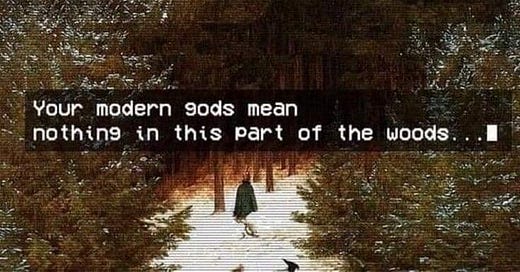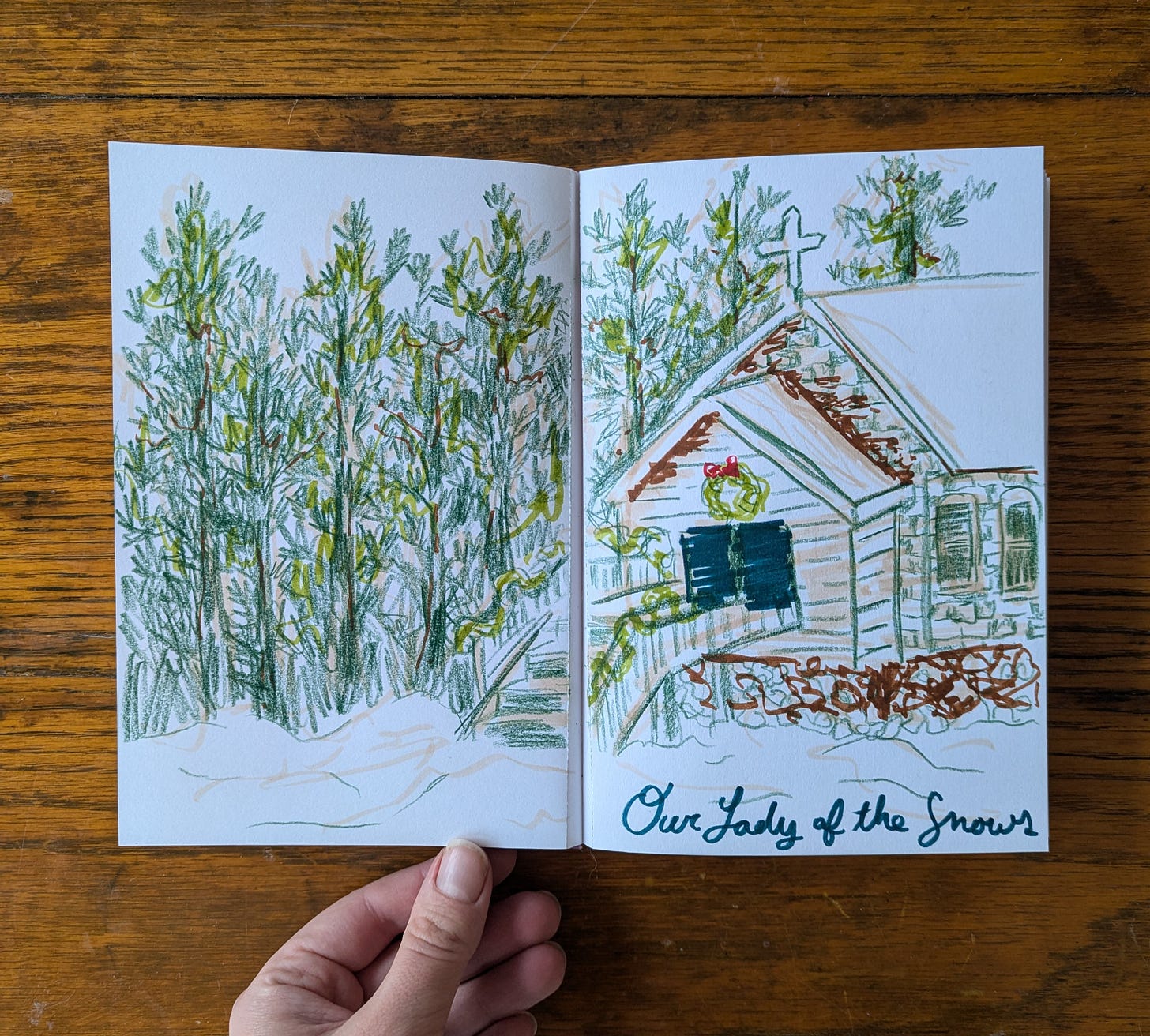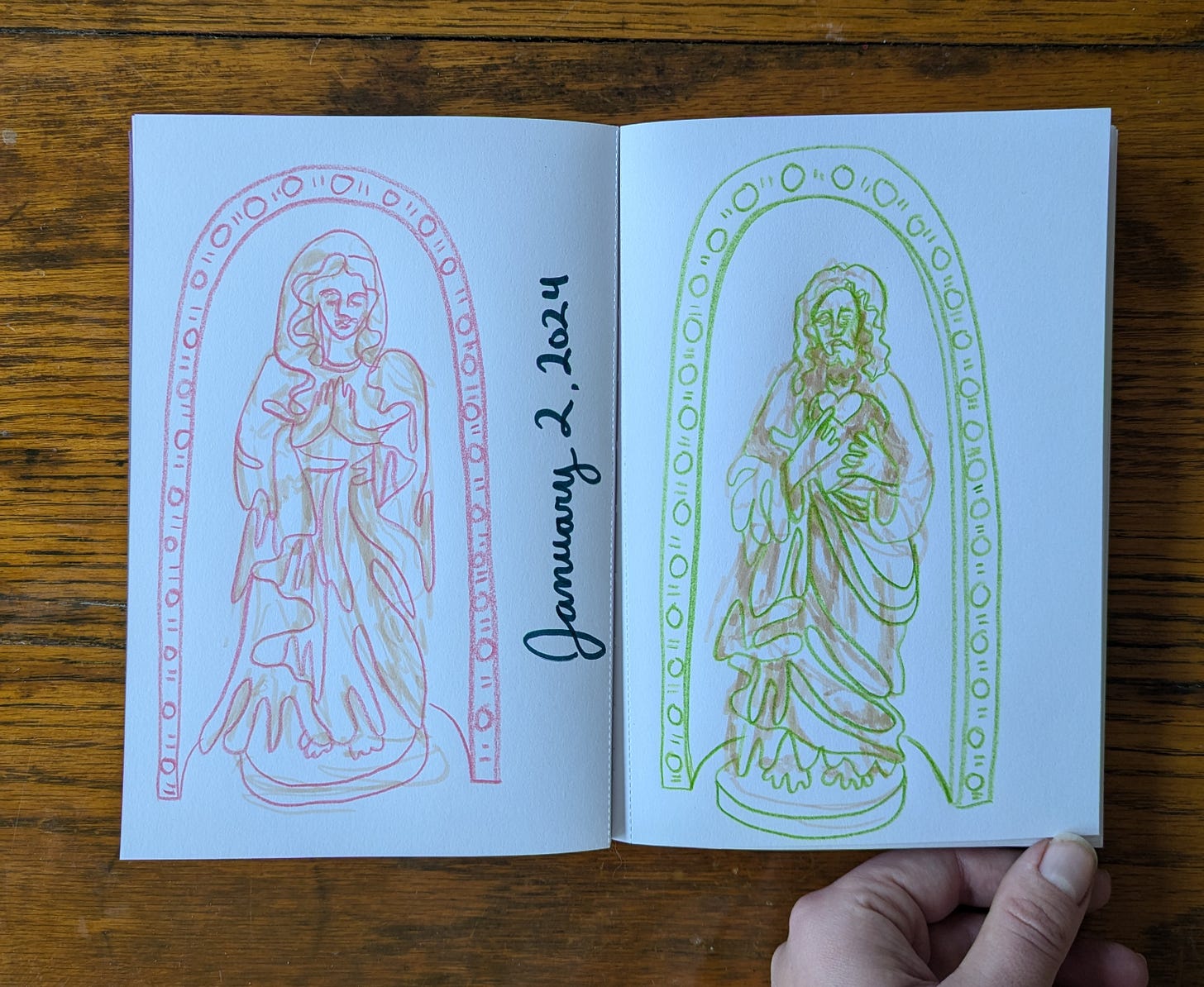Fat snowflakes fell lazily as I aimlessly drove down wintery back roads. I ignored the urge to pull out my phone and open Google maps. It was such a strange feeling to drive somewhere unfamiliar without it.
Asher and I came with Evan on a short work trip up north. We forgot the stroller, so while he worked I drove around to keep the baby happy. I felt like a teenager again when all we could do for navigation was to pull out the old red Rand McNally or print out directions from Mapquest. Otherwise, we just had to wing it.
It was oddly exhilarating to be so untethered. Though maybe anything outside of the regular routines of a postpartum nest feel that way. Regardless, I thanked Ash for reminding me how it felt to be free again.
I do this when I hike a new trail. Because most of the trails around me are on state land, there are no maps or descriptions online about how long they are or where they end up. Instead, I just walk until I find what I’m looking for. I don’t know what it is I’m looking for when I start, but I know I’ll know it when I get there. A giant old pine tree, a quiet creek, a clearing in the forest, who knows, I let it find me.
So that’s what we did.
Eventually we came to a quiet crossroads inhabited by trees. Sitting at the corner was a tiny little church named Our Lady of the Snows. It instantly caught my eye.
Never ignore anything that catches your attention at a crossroads.
I pulled into the tiny parking lot, ruining the perfect blanket of snow that, until then, was undisturbed by other tire tracks. It was a quaint little thing. I have respect for these old country churches. They aren’t flashy. They aren’t the size of stadiums like in the city, those that make me wonder where all the good people’s donations are really going.
No, these old country churches belong more to the land than to the Pope. Nestled here in the pines, it felt like Our Lady of the Snows was part of the forest, a shrine to something older and wiser. It is hobbled together with brick and stone, elements of the earth. Evergreen wreaths and garlands of the forest still hung on the door and railings. It is humble and quiet, a gentle reverence invites in the passerby. It felt like true devotion.
As I sat in the ten-car parking lot feeding Asher, I thought about this complicated relationship between land and religion. Worship of both would be highly frowned upon by the Church, but that can’t erase its prevalence. Even this little church’s name, “Our Lady of the Snows” sounds like it belongs to some old gods up in this north country.
The origin of the name is its own sort of folk tale. Back in 352 AD it is said that Mary appeared to both a childless Roman couple and the Pope in a dream. She told them to build a church on the land where snow falls in the middle of summer. Just as she foretold, snow fell on Esquiline Hill in Rome on August 5th. It was proclaimed a miracle and a church was built there.
Now each year on August 5th, a pagan feast is held to commemorate the snowfall. White rose petals are sprinkled from the dome of the chapel. The snow and the petals are both symbolic of Mary herself; full of grace, immaculate.
It’s special how snow silences things. Sitting at the feet of Our Lady of the Snows, it felt like the world was hushed in its presence. A small shrine to Mary was inlaid into the face of the church on its left side. On the right side, there was another shrine to a male statue. I had to think, was this Jesus? A disciple? A saint? There are a lot of men with beards in the bible.
I thought it was interesting that the image of Mary is often more recognizable than Jesus. Part of this is likely because there are fewer female characters in Christianity, but still Mary took on an essential role in their play.
As Christianity spread, it would be a bold statement to say Mary had a more influential role in converting land-based people than Jesus. Just look at her following in Mexico. Pagan iconography such as statues of the goddess Isis, the Mother of the Universe, in Egyptian culture were claimed by the Church and transformed into Mary, the Mother of God. The transition was seamless. In the people’s eyes, she was the same goddess, but with a different name. It’s still one of the greatest marketing ploys in history.
Similarly, she plays a huge part in the double faith of Poland. As I discussed with Gabriela Sarna, the year revolves around her. Each month has a name in reference to Mary such as Our Lady of Running Water, Our Lady of the Thunder Candle, Our Lady of Green Herbs.
Mary likely resonated so deeply with land-based people because she was most similar to their own earth goddesses. They addressed her and prayed to her as the Church instructed, but behind closed doors, in the altar corners of the home, out in the garden, under the linden trees, throughout the turning of the year, beneath whispered breaths, she retained those old beliefs that true divinity lies in the land.
It was hard for me to understand how these two conflicting versions of Mary could exist. But learning more about double faith in different cultures has helped a bit. Mary is still one of the most revered icons among Polish folk practitioners. They still address her as Mary, rather than Matka Ziemia (meaining Moist Mother Earth), her land-based counterpart.
I’m sure every practitioner has their own reasons for preserving the Christian image of her while honoring her pagan origin. But personally, I think both can exist because this is what time does. Over the centuries, Mary became an essential part of home and village life and celebration. She was ingrained into the DNA of families and generations.
This version of her provided comfort as the rest of their old gods were slain. She protected them when authorities scrutinized their rituals and remedies, the people claiming it was all done in her name after all. She gave them hope during war, drought, upheaval. It is impossible to erase this Mary.
And aren’t we the same? I think it’s normal to have our own versions of double faith within us, parts that don’t always agree with each other, but coexist nonetheless. It makes us who we are. It drives our beliefs, motivations, curiosities and reflections.
As Ash and I pulled out of that parking lot I could see the bigger picture a bit more clearly. There was the land, the immaculate snow, Mary, this old country church, centuries of conflict, centuries of worship, all gathering at a backwoods crossroads. Everything was brutally intertwined. And in that moment, history, rules, politics faded away. Everything mattered and nothing mattered. All was peaceful.
Thank you Mary, thank you forest, thank you.
Much love,
Val
P.S. Feel free to share, it’s much appreciated!
If you want to move deeper into a seasonal land-based life, consider ordering my 2025 Lunar + Seasonal Planner. Because learning to live in tune with the land doesn’t come from grand gestures or life-altering shifts, but rather from daily routines, devotions and observations of the land and how we relate to it.
This yearly planner weaves seasonal land-based practices with modern living so that you can live more intentionally and presently within every season of your life. It was created for the plant people, the land lovers, the gardeners, and the seekers to plan their lives around the rhythms of the earth as our ancestors have for thousands of years. More than just a planner, it is a practical yet spiritual guide to living, working, gardening, and celebrating in tune with the ever-shifting world around us.
Become a free subscriber for weekly musings from the forest. To receive seasonal guides and explorations, consider becoming a paid subscriber.








Ohhh, what a beautiful piece, thank you!! Have you read the book, The Way of the Rose by Clark Strand and Perdita Finn? If not I think you’d love it. ❄️🕊️
I love your thoughts on this, as I am still wading through and trying to make sense of dual faith as a practitioner with a majority Polish ancestry (which is how I found your work). It can be a lonely road to be an American, divorced from the land of my ancestors, trying to join the quilt of the land of here and now with that of traditions I never knew but somehow feel like home.
I highly suggest Polish Folk Witch on Patreon and YouTube. Specifically, she discusses this further and has many articles about Mary on her Patreon. For example, she translated a prayer for Our Lady of Sowing feast day: "Cover us with your cloak, good mother earth, and in the spring we will cover you with wonderful greenery, with a field of rustling grain and golden ears, in which all divine goodness is reflected." Another resource is "Polish Madonnas: Poems and Images" which has BEAUTIFUL artwork for the different Marys. The PDF can be found available via a University of Dayton link.